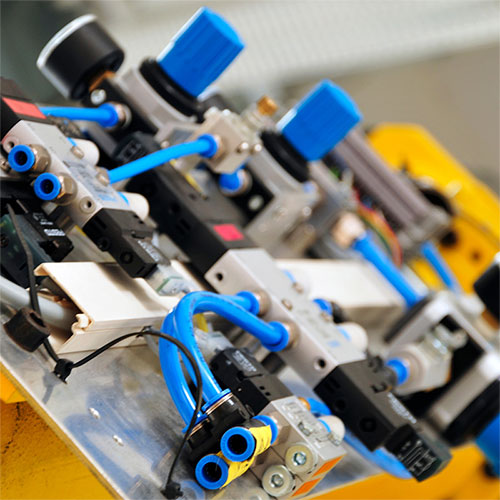The Importance of Pressure Regulation in Pneumatic Control Systems
 In the realm of pneumatic controls, pressure regulation ensures smooth and efficient operation of various industrial and mechanical systems. However, despite its importance, pressure regulation is fraught with a spectrum of common challenges that can significantly impact the systems' performance and safety. These issues, ranging from pressure fluctuations to leaks and improper calibration to component wear and tear, not only compromise the effectiveness of pneumatic controls but also pose substantial risks.
In the realm of pneumatic controls, pressure regulation ensures smooth and efficient operation of various industrial and mechanical systems. However, despite its importance, pressure regulation is fraught with a spectrum of common challenges that can significantly impact the systems' performance and safety. These issues, ranging from pressure fluctuations to leaks and improper calibration to component wear and tear, not only compromise the effectiveness of pneumatic controls but also pose substantial risks.
Common Problems with Pressure in Pneumatic Control Systems
- Pressure Fluctuations - Pressure fluctuations in pneumatic systems are often caused by variable demand or supply pressures, faulty valves, or issues with the compressor. These fluctuations are relatively common, especially in systems where the load changes frequently or supply is inconsistent. Variations in pressure can lead to inefficient system operation and even cause damage to sensitive equipment.
- Prevention: Monitoring and adjusting the system to handle varying loads regularly is essential to prevent pressure fluctuations. This includes appropriately sizing the compressor and storage tanks, installing pressure buffers, and ensuring all components are in good working condition. Routine maintenance checks and calibrations can also help identify and rectify potential causes of pressure instability before they escalate.
- Overshooting and Drop - Overshooting and drop in pressure regulation are typically caused by improper regulator settings or system components' natural wear and tear. Overshooting is when the regulator allows pressure to exceed the set point temporarily, while droop is the decrease in outlet pressure as the flow demand increases. These issues are more likely in systems that experience significant or rapid variations in flow rate or load.
- Prevention: Regular calibration of pressure regulators is crucial in preventing overshooting and droop. It's also essential to select the correct type of regulator for the specific application, considering factors like flow rate, operating pressure, and response time. Additionally, routine inspections and replacement of worn components significantly reduce these problems.
- Leaks - Leaks in pneumatic systems can occur due to several factors, including material fatigue, corrosion, improper installation, or physical damage to lines and fittings. They are a common issue, particularly in older systems or those that must be adequately maintained. Leaks cause pressure loss and can lead to increased operational costs and potential safety hazards.
- Prevention: Regular inspection of all hoses, fittings, and connections is critical to identifying and fixing leaks early. High-quality materials suitable for the specific application and environmental conditions can also help. Additionally, ensuring all components are installed correctly and according to manufacturer specifications is crucial in preventing leaks.
- Clogging and Contamination - Clogging and contamination are often due to dirt, dust, and debris accumulating within the system. These issues are prevalent in environments where the air is not filtered correctly or in systems exposed to particulate matter. Contamination can lead to reduced efficiency, damage to components, and even system failure.
- Prevention: To prevent clogging and contamination, it is essential to use air filters and regularly replace or clean them. Ensuring the system is adequately sealed and protected from environmental contaminants is also necessary. Regular system cleanings and inspections can help identify and address any build-up of pollutants before they cause significant problems.
- Incorrect Sizing or Selection - Incorrect sizing or selection of pressure regulators and other system components often occurs due to a misunderstanding of the system's requirements or simply selecting based on cost rather than suitability. This is a frequent issue in systems that are either newly designed or have undergone modifications. Using a too large or too small regulator for the application can lead to poor control and inefficiency.
- Prevention: Accurate assessment of the system's requirements, including flow rate, operating pressure, and environmental conditions, is essential in selecting the right components. Consulting with experts or using software tools for system design can help ensure all components are appropriately sized. Regular performance evaluations can also identify if the current setup is optimal or needs adjustment.
Ensure Top Performance of Pneumatic Control Systems
By understanding and addressing these common issues, individuals and organizations can enhance the safety, efficiency, and longevity of their pneumatic systems. Regular maintenance, correct component selection, and staying informed about system requirements and best practices are essential to successful pressure regulation.
We are your one-stop shop for everything related to pneumatic control systems. Ellis Kuhnke Controls is both a manufacturer and distributor of pneumatic industrial controls. Our company has been in business since 1962. We manufacture and distribute a complete line of primarily pneumatic control devices. These include pneumatic timers, indicators, counters, valves, cylinders, regulators, rotary actuators, and various fittings.
Give our team a call for more information.
Related Reading


- Ellis/Kuhnke Controls
132 Lewis Street Unit A-2, Eatontown, N.J. 07724
Phone: 1-800-221-0714
Fax: 732-291-8154
Email: Info@ekci.com
- Home Pneumatic Controls Technical Info CAD Drawings Contact Us Pneumatic Timers Blog Site Map
